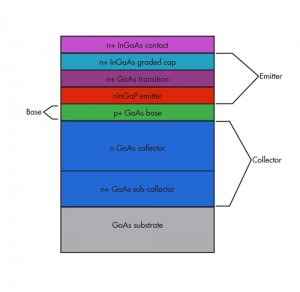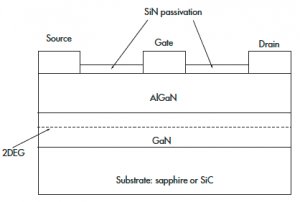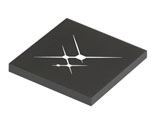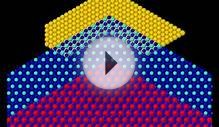 The need for high power in the VHF, UHF, and microwave bands has led to transistors that can easily supply tens to hundreds of watts at RF frequencies to 10 GHz and beyond. Most of these devices are made with gallium arsenide (GaAs) or gallium nitride (GaN).
The need for high power in the VHF, UHF, and microwave bands has led to transistors that can easily supply tens to hundreds of watts at RF frequencies to 10 GHz and beyond. Most of these devices are made with gallium arsenide (GaAs) or gallium nitride (GaN).
Semiconductor Types
GaAs and GaN are compound semiconductors. Known as III-V semiconductors, they fall into categories of elements with either three or five valence electrons. Boron, aluminum, gallium, indium, and thallium are Category III elements. Nitrogen, phosphorus, arsenic, antimony, and bismuth are Category V elements.
 Combining a Category III element with a Category V element produces a covalent bond with eight electrons, yielding a unique semiconductor. Such semiconductors have higher electron mobility than silicon, so they’re more useful at higher frequencies. GaAs and GaN have been found particularly useful for microwave power amplifiers.
Combining a Category III element with a Category V element produces a covalent bond with eight electrons, yielding a unique semiconductor. Such semiconductors have higher electron mobility than silicon, so they’re more useful at higher frequencies. GaAs and GaN have been found particularly useful for microwave power amplifiers.
Transistor Types
You can use GaAs or GaN to make any type of transistor including the most popular, like bipolar junction transistors (BJTs) and enhancement-mode MOSFETs. But other types have emerged, such as heterojunction bipolar transistors (HBTs), metal-semiconductor FETs (MESFETs), high electron mobility transistors (HEMTs), and laterally diffused MOS (LDMOS). These transistors take advantage of the materials to produce the best amplifying and power handling capability.
These transistors take advantage of the materials to produce the best amplifying and power handling capability.
HBTs use the standard BJT configuration but use different materials for the base and emitter. One popular combination, a GaAs emitter and an aluminum-gallium-arsenide (AlGaAs) base, yields very high gain at microwave frequencies out to 150 GHz.
A MESFET is essentially a JFET with a metal gate that’s used to form a Schottky junction with the main conducting channel. The operation is depletion mode, where the device is normally on and is turned off by a applying a negative gate voltage. MESFETs are usually made with GaAs and have high gain at microwave frequencies.
RELATED VIDEO
